|
DAY 5. THURSDAY, AUGUST 15, 2002
A more leisurely rising than usual this morning was possible, because we did
not have a great distance to cover, plus we would be traveling pretty fast
for the first five miles or so.
Leisurely meant that we were underway by 8:00 am.
Heat was not a problem as we left our camp in Furnace Flats, because we were
immediately swept into the 25-foot drop of Unkar Rapid, whose rating of 7 is
not an exaggeration. It was thrilling, cooling and wet.

|
Bill and Jennifer
|
Larry Roberts kept a watchful eye on me as we rode in the stern of Scotty
Steven's boat while Gary Truitt and his son, Stephen rode in the bow. It
seems that Larry spent a good deal of time watching over all of us. Bill
tells me that Larry probably saved their lives on a couple of occasions. I
know that he was a big help to me in getting me back down the trail up to the
Anasazi Granaries at Nankoweap.
Our soakings continued as we hit Nevills Rapid a little over two miles beyond
Unkar, and within a mile we roared through the 30-foot drop of Hance Rapids,
rated 9 to 10. Fun! Scotty's self-bailing boat made this a lot easier on us
passengers.
Immediately beyond Hance we entered the dark to almost black, sheer walls of
the Vishnu Schist, of the inner gorge. Here we are in the oldest rock
structures in the Grand Canyon. Geologists tell us that this layer is
composed of the metamorphosed layers of the roots of ancient mountains. The
tremendous forces of pressure and heat have completely obliterated any record
of what sediments or conglomerates may have been laid down here in past eons.
They also tell us that these dark cliffs are probably half as old as the
earth itself. We have now descended into the deepest and the oldest layer of
rock in the Canyon, and we have traveled back in time beyond comprehension.
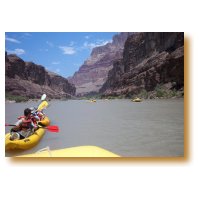
|
I am looking back from Scotty's boat at the other boats and kayaks as we
cruise on our way from Hance Rapid behind us, on the way to Sockdolager Rapid
in the Inner Gorge.
|
The layers of rock here in the Grand Canyon are opened up for us like the
leaves of a grand book, and they are opened more completely than anywhere
else in the world. Their unique exposure makes it possible for them to be
examined more clearly than in any other location. Nowhere else is it possible
for us to study these awesome pages in surroundings of such unmatched beauty.
John Wesley Powell put it this way: In "The Exploration of the Colorado River
and its Canyons" he says, "Each wall of the canyon is a composite structure,
a wall composed of many walls, but never a repetition. In the Grand Canyon,
there are thousands of gorges like that below Niagara Falls, and there are a
thousand Yosemites. Yet, all these canyons unite to form one Grand Canyon,
the most sublime spectacle on earth. The traveler on the brink looks from
afar and is overwhelmed with the sublimity of massive forms; the traveler
among the gorges stands in the presence of awful mysteries, profound, solemn
and gloomy. The glories and beauties of form, color, and sound unite in the
Grand Canyon . . . if strength and courage are sufficient to the task, by a
years toil (my italics), a concept of sublimity can be obtained never again
to be equaled on the hither side of Paradise."
As we cruise on down to Sockdolager Rapid we pass a "Baloney Boat" of Western
River Expeditions. They have apparently paused for a lunch break prior to
roaring on through. Powell gave the name "Sockdolager" to this rapid,
because back in his time a sockdolager was a knockout punch in a boxing
match. As you can see from the photo, there was no way to portage equipment
or line his wooden boats around a danger in this part of the canyon. He had
no choice but to take-it-on-the-chin, and ride the rapids out.
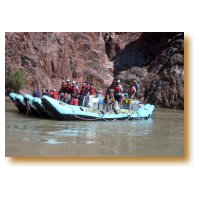
|
Skippers of oar powered rafts and Dories refer to these huge motor powered
rafts as "Baloney Boats."
Note the Tamarisk tree just off the bow of the big raft. Also note the type
of terrain in which the tamarisk is able to survive.
|
Two and a half miles below Sockdolager we roared through Grapevine, and in
another two and a half miles we hit Zoroaster. Under Scotty's supervision
Steve Truitt, Gary's son, manned the oars for our boat throughout most of the
morning. Downstream from Grapevine he was our skipper for the rest of the
way, except for the actual beaching of the boat at Bright Angel Beach, when
Scotty took over. Steve had been given the opportunity to do this several
times previously back up above Nankoweap, and with experience he was becoming
more accomplished. Each rapid he encountered elevated his skill a notch, and
by the time we arrived at our lunch stop at Cremation Canyon he looked like a
seasoned swamper.
Lunch was a lazy affair, with time for picture taking. Time for everyone
except me, unfortunately. Just as I was getting up from my position where I
had posed on the beach for other photographers, the order was given to hop
back in the boats, and I never got shot with my camera. I have contacted
several people in an attempt to locate a group photograph, but have been told
that the pictures were unsatisfactory for one reason or another, so for the
first time on any of the trips I have taken in the canyon I don't have the
group as a whole on film.
As we cruised gently down the river for the last few miles, I felt nostalgic
as I viewed Clear Creek, Sumner Butte, the Clear Creek trail high up on the
right side just under the cliffs below the Tonto Platform, and other areas
where we had hiked on previous trips, when I was younger, stronger and had
more balance. There was a hollow, aching sensation of sadness in me as I
looked at all of this, probably for the last time. However, I reminded
myself that Bill and I had made the right decision back in the mid-80s when
we said we would do this while we were young enough and healthy enough to do
it. We have hiked, camped and rafted in the Grand Canyon nearly every year
for the past 16 years, and are better men for having done it.
Had it not been for Jennifer we might not have done it this year. She has
thoroughly enjoyed herself in the hiking and camaraderie. Kevin Roberts has
taken to the canyon like a colt in a rye patch. The obvious enthusiasm of
these two has added a lot to the trip for all of us.
Too soon the black bridge came into view. I am always fascinated by the
knowledge that the cables from which this bridge is suspended were snaked
down the seven miles of tortuous trail from the rim at Yaki Point on the
shoulders of 42 Havasupais. Each of the ten supporting cables from which the
bridge is hung are an inch and a half in diameter, 548 feet long and weighing
2,030 pounds. No system could be found do load them on pack mules, so it was
decided to have them carried down on the shoulders of strong men. Constructed
in 1928 to replace the 1920 bridge that was supported by two 7/8 inch cables,
most of the work was done during the winter, as the canyon walls became
unbearably hot during the heat of summer days. (Summer work on the North
Kaibab Trail leading up to the North Rim was done at night under flood
lights.) The 440 foot length of the 5 foot wide bridge has no grating or gaps
for good reason. Mules, horses, donkeys or oxen will not step on a bridge
when they can see through the walkway to the water below. Pack trains
bringing supplies and the trains bearing tourists would never cross the river
on a see-through bridge, like the Silver Bridge a mile downstream.

|
This is a view looking back upstream after we have passed under the bridge.
|
On previous occasions It has been an exciting thing to view this structure,
because it meant that we were close to Bright Angel Creek with its crystal
clear waters, the beach with its warm sands where we could swim and play, and
Phantom Ranch with its shade, its showers, and always someone new with whom
to talk to and swap stories of canyon experiences. This time there was a
sadness mingled in with all of those feelings.
We tied up at the beach, officially known as Roys Beach, named for "Roy"
Starkey who used to serviced the gage, made measurements of flow, and
reported river stages until these functions were automated by equipment on
the Data Collection Platform that was installed in 1977. I have seen the name
Roys Beach in books, but I have never heard anyone call it that. It is
commonly known as Bright Angel Beach.
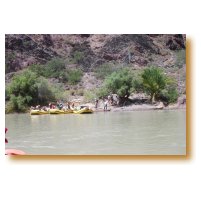
|
More Tamarisk trees are visible above the beach. We note that the beach is
considerably smaller than it was on our first visit in 1987, and smaller than
when we unloaded here in 1997. The decrease of the sand here is one of the
effects of the Glen Canyon dam. Without the annual spring floods to bring
down sand the beach is no longer replenished, and is slowly being washed
away.
|
All of us mingled our farewell's to the crew with our busy activities,
unpacking our water proof bags, and repacking our duffle bags which would be
loaded on the mules in the morning. At last we slung our duffels over out
shoulders, and headed up the trail beside Bright Angel Creek to Phantom
Ranch. Twenty-six to twenty-eight pounds may not seem like much when you
discuss it while seated in an arm chair at home; however, it seems like
eighty to a hundred on your back or shoulders by the time you get up to the
Dining Hall and office of Phantom Ranch three quarters of a mile away on a
one hundred degree August day. Nevertheless, motivated by the visions of the
premier beer awaiting us we all made it without heat strokes or other
injuries.
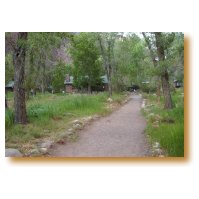
|
The shade of the cottonwoods, the greenery made possible by the irrigation
ditches and the knowledge that we are "almost home" adds a lot to the joy of
the last few paces to our destination.
|
Phantom Ranch had its origin in the '20s as the base camp for the
construction crews working on the North Kaibab Trail. Later Dave Rust used
the facilities as a stop over for tourist parties that he guided into the
canyon. He was the one who dug the irrigation ditches, and planted the
cottonwood trees that make the camp such a beautiful oasis today. One result
of Teddy Roosevelt's visit in 1903 was that in 1913 "Rusts Camp" name was
changed to "Roosevelt Camp." Roosevelt was so impressed by the beauty of the
canyon, that he said it was "to me the most impressive piece of scenery that
I have ever looked at." In a speech at the Grand Canyon he expanded on his
feeling:
"In the Grand Canyon, Arizona has a natural wonder which, so far as I know,
is in kind absolutely unparalleled throughout the rest of the world. I want
to ask you to do one thing in connection with it in your own interest and in
the interest of the country -- to keep this great wonder of nature as it is
now ... I hope you will not have a building of any kind, not a summer
cottage, a hotel or anything else to mar the wonderful grandeur the
sublimity, the great loveliness and beauty of the canyon. Leave it as it is.
You cannot improve on it. The ages have been at work on it, and man can only
mar it. What you can do is to keep it for your children, your children's
children, and for all who come after you, as the one great sight which every
American ... should see."
Roosevelt's visit was instrumental in getting the Grand Canyon established as
a National Park. Senator Benjamin Harrison had first introduced a bill to get
this done back in 1882, and again in 1883. Under pressure from Roosevelt the
Grand Canyon Game Preserve was created in 1906, and he later created the
Grand Canyon National Monument in 1907. Finally after Representative Carl
Hayden and Senator Henry Fountain Ashurst of Arizona were able to get bills
passed to establish the Grand Canyon as a national park in 1918, President
Woodrow Wilson signed the Grand Canyon National Park bill on February 26,
1919. It took a long struggle of 17 years by many powerful people overcoming
the special interests (of men like Ralph Cameron, who had blocked the
legislation every step of the way with illegal mining claims and other
maneuvers) to succeed in giving the rest of us the Grand Canyon.
In the early twenties the Fred Harvey Company hired a brilliant,
strong-willed, Pennsylvania lady from Philadelphia to design a number of
buildings for the Grand Canyon, including Desert View at the East end of the
Park, Hermits Rest at the West end, Hopi House and The Bright Angel Lodge at
the Grand Canyon Village. She designed, and closely supervised the dining
hall and the cabins at Roosevelt Camp, and had it renamed Phantom Ranch,
after Phantom Creek, which flows into Bright Angel Creek just north of the
camp. Earlier visitors had named the creek Phantom, because of the
phantom-like haze over the water up in its canyon.
Anyone who has been lucky enough to spend some time at Phantom Ranch is well
aware that there has not been "…a building of any kind," here, "…to mar the
wonderful grandeur…" as Roosevelt requested.

|
Here is a view of the dining hall as it looked on our hike in 1987.
|
After checking in at the desk to the left as you enter the dining hall, (
also the counter where you buy T-shirts and other gifts, post cards, stamps,
and refreshments) we got the keys to cabin number 8, entered it, and began to
relax. Bill, Phil, Gary Truitt and I occupied the rear room of the cabin,
while Jennifer bunked in the front room along with Faith Dekter, her son Paul
Dekter, Russel and Trista Cher, and Russel's brother Paul Sher. One may
think it odd that we would bunk in a coed manner; however there was a good
deal more privacy in this 8 bunk cabin than there was in the campsites where
we had been sleeping for the past several nights.
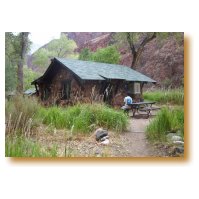
|
Paul Dekter relaxes in front of our cabin during the afternoon of Thursday,
August 15.
|
It's surprising how the fragrance of my body rapidly becomes overpowering
when I return to civilization after camping for several days. This situation
was rapidly remedied with clean clothes and a shower. Remembering my
experiences here on previous trips, I took a plastic bag with me over to the
shower building to stuff my dirty clothes in. Also, remembering previous
trips, I wisely put my dirty clothes in the plastic bag, and sealed it prior
to taking the shower. There is nothing quite like several days camping to
give you a real appreciation of showers with real soap, and then clean
clothes.
We packed our gear in the duffle bags that we had brought with us in order to
have them carried out on mules the next day. We Carried the bags to the
scales in back of the Dining Hall to weigh them and label them. I was
pleasantly surprised to see that my duffle weighed only 24.5 pounds.
Anything over 28 pounds gets costs an extra fee. I was also pleasantly
surprised to discover that the pack had decreased in weight from 60 pounds to
24.5 pounds simply by removing it from my shoulders.
While we were in the process of getting all of these chores done, Al Roberts,
Phil's brother, showed up. He was camped in the Bright Angel Campground,
having hiked down from the South Rim, and he strolled up to meet us for
supper. We were going to hike out together the next morning.
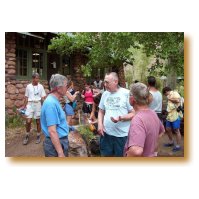
|
From left: Phil Roberts, Bill Huggins and Al Roberts(in maroon shirt) with
his back to us discuss plans for an early start up the trail to the South Rim
in the morning. The dining hall-snack bar-gift shop is the stone building to
the left.
|
Phantom Ranch serves two menus. One is stew, and the other is steak OARS had
signed us for the stew dinner. Both dinners are excellent, and there is
always plenty to eat. Those Phantom Ranch folks know the appetites of hikers
and mule riders.
In 1987 we were served in fine rustic atmosphere with wooden tables. The
Health Department has decided that wood harbors bacteria, so for the past
several years visitors have served on sterile, vinyl topped tables. That
spoils it for me. No matter that we now know that vinyl harbors more
bacteria than wood, and that wood topped tables are less likely to be related
to food poisoning than vinyl, the Health Department bureaucrats have decreed
that it must look sterile, and it certainly does. These same types have done
away with the swimming pool that used to be there for the cooling enjoyment
of tired hikers and campers. No matter that it was filled, and constantly
renewed from the continuous flowing waters of crystal clear Bright Angel
Creek. With constantly flowing water entering the top end of the pool and
leaving the bottom end it was impossible to properly chlorinate the pool.
Under the command of the Health Department bureaucracy the beautiful pool was
filled in. It is so sad.
In spite of this minor change in the atmosphere of the mess hall and camp,
the camaraderie and pleasant conversation made our last meal together a
wonderful experience.
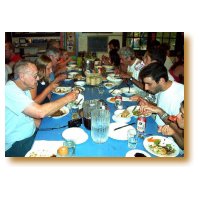
|
On the left side of the table from left we are: Bill Huggins, Jennifer
Huggins, Phil Roberts, top of the head of his son Larry Roberts and Larry's
son, Kevin Roberts.
On the right side of the table from right we are: Trista Sher and then her
husband, Russel Sher, then Russel's little brother Jonathan Sher, then father
Michael Sher, then Michael's sister Faith Dekter, and at the end of the table
(opposite Kevin Roberts) is Faith's son, Paul Dekter.
|
The evening was spent shooting the breeze, arranging our day packs for the
hike out the next day and writing cards to friends and family, which cards
would be sent out on mule back with the Phantom Ranch post mark on them.
That's always a fun thing to receive in the mail.
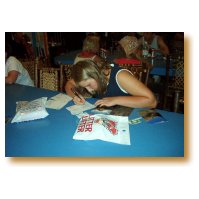
|
Jennifer writing to family and friends. These cards will be postmarked
Phantom Ranch, and will be sent out on mule back in the morning.
|
Bill, Phil, Al and I decided to get an early start in order to avoid hiking
in the worst heat of the day, so we arranged to have a breakfast plus a lunch
prepared for us. Phantom Ranch personnel routinely prepare a mid day lunch
for hikers to carry up the trail, and they were happy to prepare an extra
morning snack for us. That way we would be able to start out at 4:30 or so.
Gary Truitt decided to hike out with us. Young, agile Steve Truitt could
start out any time he desired, and would still beat us out by a couple of
hours.
Having completed these arrangements we turned in for the night.
|